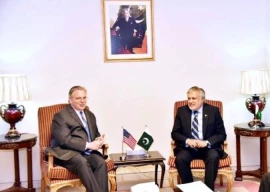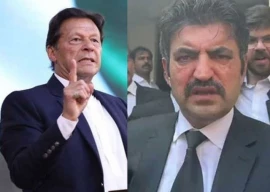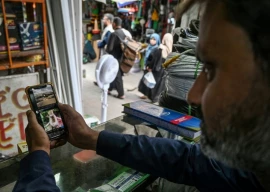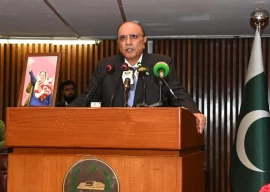
MITHI: Two elderly turbaned men wearing traditional dhotis were gossiping in Dhatki, the language spoken in Tharparkar and Umerkot districts of Sindh. One introduced himself as Bheru Menghwar and the other as Faqir Muhammad Dars, both residents of Munghat village, some 100 kilometres away from Mithi Town.
Munghat is an oasis of religious harmony in a country where minority communities often complain of discrimination and persecution. This peaceful coexistence of Hindus and Muslims is not unusual for this impoverished desert district where a sense of togetherness transcends all ethnic and communal affiliations.
“We, Hindus and Muslims, have lived like one family in this village for the last 200 years. Not a single communal feud has ever been reported that could have threatened communal harmony here. We share each other’s joys and grief. Not only do we live together, but also share a common graveyard to bury our dead. There is just one thin border line. One side is for Hindus and other for Muslims,” said Faqir Dars, 85.
According to local people, the Hindus participate in Muslim religious festivals like Eid and Ashura-e-Muharram. Similarly, Muslims attend Hindu festivals like Diwali and Raksha Bandhan. Many Hindu women also tie Rakhi to their Muslim brothers.
“Many Hindus set up Sabeel for mourners in Muharram, and Muslims in many areas of Tharparkar don’t eat beef out of respect for Hindus who consider the cow as sacred,” said local journalist Khatao Jani. “These people are socially integrated, which is why there has been no dispute between Hindus and Muslims. Generally too, the crime rate in the district is negligible,” he said.
According to the 1998 census, 64% Muslims and 36% Hindus live in Tharparkar, but not a single incident of forced conversion, kidnapping for ransom and extortion has been reported here in recent memory.
Some settlers have now arrived in Mithi and other towns who have tried to commit crimes, but independent statistics reveal that Tharparkar is still the most nonviolent district of Pakistan. “People are starving due to persisting drought, but you will not see anyone forcibly shutting down markets,” said Sindhi writer Arbab Naek Muhammad.
Haji Muhammad Dal, 83, is famous in Mithi because he serves food to drought victims and arranges separate vegetarian meals for Hindus. This elderly man, sharing eyewitness account, narrated how Hindus and Muslims protected their hometowns in the 1965 and 1971 Pakistan-India wars. “In 1971, Nagarparkar and Islamkot were under occupation of Indian troops who had hoisted their flag. We, both Muslims and Hindus in Mithi, were armed against the enemy and would patrol our areas,” he said.
He added that except for some people who migrated to India, various clans of non-Muslims, including Rajput, Thakur, Menghwar, Kohli and Bheel were equally charged up against Indian aggression to save their motherland. He said that after the demolition of Babri mosque by Hindu zealots in India, some outsiders reached Mithi and tried to set a temple on fire “but we all foiled their conspiracy”.
Zaffar Junejo, a community development expert who works as CEO of Thardeep Rural Development Organisation, has another view. He disagrees that tolerance, harmony and peace in Thar is because of social integration. “Here, almost all people are relatively disadvantaged. Muslims and Hindus have similar economic profiles. There is no gap between the rich and the poor; it is economic disparity that can create a sense of deprivation and lead to crime,” he said.
Junejo said the area was isolated earlier, but with the construction of roads and other means of communication, the situation has now changed. “Till a few years ago, judges used to sit idle in their courts because there was no case to be heard. People had no guns and there was no concept to lock doors of houses. But now, hearings of criminal cases have started and one weapon shop has been opened in Mithi. I think the prevailing situation is giving a new shape to life in Tharparkar.”
Published in The Express Tribune, December 6th, 2014.
COMMENTS (7)
Comments are moderated and generally will be posted if they are on-topic and not abusive.
For more information, please see our Comments FAQ























































I live in Delhi and have visited Lahore twice. On both occasions have had a wonderful time and made many good friends. Our sectarian problems are so similar and at least a partial solution lies in the spread of feel good stories like this. Keep it up. I wish these examples are disseminated in both countries rather than the killings and hatred that is so common.
So only Hindu majority district of Pakistan, Tharparkar, has now become Muslim majority district.
Oh! So, they are living without 2 Nation's Theory? :)
I love this. All of us Pakistanis should be united like this.
Pakistan is a peacefool nation?
Thar reflects the future set up of The Pakistan .
Thank you ET for bringing up such positive stories of Sindh Pakistan. Country is marred with sectarian, religious and ethnic conflicts, such stories show the humane, benignant, tolerant and pluralist side of Pakistan, it makes me feel proud to be Pakistani. My love goes to Tharparkar Sindh. Please give more space to such stories. Wish Pakistan becomes pluralist, tolerant, peaceful, and secular country.